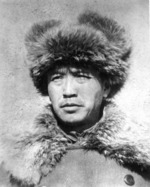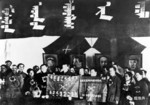Ulaan Huu
| Given Name | Ulaan Huu |
| Born | 23 Dec 1906 |
| Died | 8 Dec 1988 |
| Country | China |
| Category | Government |
| Gender | Male |
Contributor: C. Peter Chen
ww2dbaseUlaan Huu (also translated as Ulanhu or Ulanfu) was born just outside the city of Guihua (later Kweisui/Guisui, now Hohhot) in Tumed Left Banner in the Inner Mongolia region of Qing Dynasty China. His parents were herders. He went to elementary school in his hometown, and went on to study at the Mongolian-Tibetan College in Qing's capital Beiping (now Beijing) in early 1923. He joined the Socialist Youth League of China, the forerunner of Communist Youth League, in Dec 1923. In 1925, he joined the Communist Party of China. In Sep 1925, he attended the Sun Yat-sen Communist University of the Toilers of China in Moscow, Russia; at this Comintern school, he shared a desk with Chiang Ching-kuo, the son of the Nationalist Party chairman Chiang Kaishek. He returned to China in Jun 1929 and became a member of the Western Mongolia Working Committee of the Chinese Communist Party. In Oct 1931, he was given high ranking positions involving Communist military, political, and intelligence efforts in the region.
ww2dbaseDuring WW2, with his headquarters established at Ikh Juu League (now Ordos), Suiyuan Province, China, Ulaan Huu led a band of Communist forces in a guerrilla campaign against Japanese-sponsored mercenary forces marching toward Kweisui (Pinyin romanization: Guisui; now Hohhot), Suiyuan Province in late 1936. While Nationalist regulars under General Fu Zuoyi bore the brunt of the fighting during the Battle of Suiyuan, Communist partisans nevertheless contributed to the defeat of Japan's puppets. Between 1937 and 1940, he continued to conduct guerrilla missions against Japanese and Nationalist targets in Suiyuan Province and northern Shaanxi (Pinyin romanization: Shensi) Province. In Apr 1938, he was made a party committee member for the Suiyuan-Mongolia region. In May 1938, toward the nominal Nationalist-Communist cooperation effort, he was made a political officer within the Nationalist 3rd Division during the division's campaign to stop the Japanese Army from crossing the Yellow River. In Aug 1941, Nationalists purged him out of 3rd Division, and he relocated to Yan'an, Shaanxi Province, the main base of the Chinese Communist Party. While at Yan'an, he was initially placed in charge of ethnic affairs in the region where the borders of Ninxia, Suiyuan, Gansu, Shaanxi provinces met. In Aug 1943, he was placed in charge of Mongolian ethnic affairs for an expanded region.
ww2dbaseIn Aug 1945, Ulaan Huu was made the chairman of the Communist Suiyuan-Mongolia administrative region, committee member of the Shanxi-Chahar-Hebei Border Region Central Bureau, and Secretary of the Inner Mongolia Working Committee. In Oct 1945, he began leading efforts in organizing an autonomous government for ethnic Mongolians in the Inner Mongolia region. With Communist forces in his disposal, he engaged in attacks against Nationalist sympathizers and local bandits in regions under his influence. In May 1947, he was officially made the Acting Governor and founding Chairman of the Autonomous Government of Inner Mongolia by the Communist leadership. In 1948 and 1949, Ulaan Huu led troops against Nationalist forces during the Pingjin Campaign in Heibei Province and the Liaoning-Shenyang Campaign in northeastern China. In 1949, as the Republic of China relocated to Taiwan amidst defeat in the Civil War, the Communists declared the founding of the People's Republic of China; Ulaan Huu was made the Communist Party Secretary at that time, as well as being appointed the Chairman of Inner Mongolia. In Sep 1954, he was made Chairman of State Ethnic Affairs Commission and the Vice Premier of Communist China. In the following year, he was promoted to the rank of general and was inducted to the 57-member "founding generals" clique. In 1966, during the Cultural Revolution purge called for by Communist leader Mao Zedong, mobs formed by youth organizations attempted to take control of government buildings in Inner Mongolia; he was initially successful in protecting government buildings by deploying military forces under his command, but he was ultimately forced to surrender when Mao ordered him to stand down with the threat of force. In Aug 1966, he was sacked from his chairmanship after being falsely accused of leading an Inner Mongolian separatist movement and was imprisoned in Beijing. Under the protection of Premier Zhou Enlai, his life was spared. Between late 1966 and 1972, he lived under the pseudonym of Wang Zili. In late May 1972, Mao pardoned him and allowed him to return to politics. During the Tenth National Congress of the Chinese Communist Party, which was held between 24 and 28 Aug 1973, he was made a Party Central Committee member. In Jan 1975, he was made the Vice Chairman of the National People's Congress Standing Committee. During the Eleventh National Congress of the Chinese Communist Party, which was held between 12 and 18 Aug 1977, he was made a member of the Political Bureau. Between 1977 and 1982, he was the head of the United Front Department. During the Twelfth National Congress of the Chinese Communist Party, which was held between 12 and 13 Sep 1982, he was again made a member of the Political Bureau. In early Jun 1983, he was made the second candidate for the position of Vice President of Communist China. On 10 Jun 1983, the first candidate Liao Chengzhi suddenly passed away from a heart attack, Liao Chengzhi. Eight days later, Ulaan Huu was made the Vice President. In 1985, he resigned as a member of the Political Bureau. His term as the Vice President ended in Mar 1988. In the following month, he was made the Vice Chairman of the National People's Congress Standing Committee. He passed away from illness at 1445 hours on 8 Dec 1988.
ww2dbaseUlaan Huu was also known by his Sinicized names Yun Ze and Yun Shiyu.
ww2dbaseUlaan Huu was maried twice, first to Yun Ting, then to Yun Liwen. Several of his four sons and four daughters held prominent political or business positions, including his son Buhe (Sinicized name: Yun Shuguang), who served as Chairman of Inner Mongolia between 1983 and 1993, the same position Ulaan Huu held between 1949 and 1966. Buhe's daughter Bu Xiaolin, in turn, held the same position once again starting in Jun 2016, marking the third generation of the family having held this chairmanship.
ww2dbaseSource: Wikipedia
Last Major Revision: Apr 2018
Photographs
 |  |
Ulaan Huu Timeline
| 23 Dec 1906 | Ulaan Huu was born in the Inner Mongolia region of Qing Dynasty China. |
| 18 Jun 1983 | Ulaan Huu was made the Vice President of Communist China. |
| 15 Mar 1988 | Ulaan Huu stepped down as the Vice President of Communist China. |
| 8 Apr 1988 | Ulaan Huu was made the Vice Chairman of the National People's Congress Standing Committee. |
| 8 Dec 1988 | Ulaan Huu passed away from illness at 1445 hours in Beijing, China. |
Please consider supporting us on Patreon. Even $1 per month will go a long way! Thank you. Please help us spread the word: Stay updated with WW2DB: |

» Battle of Suiyuan
- » 1,182 biographies
- » 337 events
- » 45,119 timeline entries
- » 1,249 ships
- » 350 aircraft models
- » 207 vehicle models
- » 376 weapon models
- » 123 historical documents
- » 261 facilities
- » 470 book reviews
- » 28,415 photos
- » 365 maps
Joachim von Ribbentrop, German Foreign Minister, Aug 1939